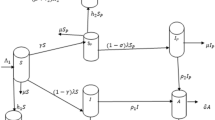Abstract
The aim of this paper is to analyze the recruitment effects of susceptible and infected individuals in order to assess the productivity of an organizational labor force in the presence of HIV/AIDS with preventive and HAART treatment measures in enhancing the workforce output. We consider constant controls as well as time-dependent controls. In the constant control case, we calculate the basic reproduction number and investigate the existence and stability of equilibria. The model is found to exhibit backward and Hopf bifurcations, implying that for the disease to be eradicated, the basic reproductive number must be below a critical value of less than one. We also investigate, by calculating sensitivity indices, the sensitivity of the basic reproductive number to the model’s parameters. In the time-dependent control case, we use Pontryagin’s maximum principle to derive necessary conditions for the optimal control of the disease. Finally, numerical simulations are performed to illustrate the analytical results. The cost-effectiveness analysis results show that optimal efforts on recruitment (HIV screening of applicants, etc.) is not the most cost-effective strategy to enhance productivity in the organizational labor force. Hence, to enhance employees’ productivity, effective education programs and strict adherence to preventive measures should be promoted.







Similar content being viewed by others
References
Coulibaly, I.: The Impact of the HIV/AIDS on the Labour Force in Sub-Saharan Africa: A Preliminary Assessment. International Labour Organisation. Website: www.ilo.org/aids (2003)
Bendavid, E., Young, S.D., Katzenstein, D.A., Bayoumi, A.M., Sanders, G.D., Owens, D.K.: Cost-effectiveness of HIV monitoring strategies in resource-limited settings: a southern African analysis. Arch. Intern. Med. 168(16), 1910–1918 (2008)
Joshi, H.R.: Optimal control of an HIV immunology model. Optim. Control Appl. Math. 23, 199–213 (2002)
Okosun, K.O., Makinde, O.D., Abiodun, G.J.: Transmission dynamics of HIV/AIDS with optimal control in the presence of carefree susceptibles and treatment. BIOMAT: International Symposium on Mathematical and Computational Biology: 2011. A Chapter in BIOMAT book series, pp. 131–152. World Scientific Publishing Co. Pte. Ltd. (2012)
Bullert, B.: Effectively Managing Team Conflict. Global Knowledge Training LLC (www.globalknowledge.com) (2006)
Lori, B., John, S., Eleni, S.: The Economic Impact of AIDS in Ethiopia. The Future Group International, with collaboration with Research triangle Institute and The Centre for Development and Population Activities (1999)
Vass, J.: A Review of Labour Markets in South Africa: The Impact of HIV/AIDS on the Labour Market. Employment and Economis Policy Research Programme, Human Sciences Research Council (HSRC) (2005)
Anderson, R.M., Medly, G.F., May, R.M., Johnson, A.M.: A preliminary study of the transmission dynamics of the human immunodeficiency virus (HIV), the causative agent of AIDS. IMA J. Math. Appl. Med. Biol. 3, 229–263 (1986)
Nikolaos, I.S., Dietz, K., Schenzle, D.: Analysis of a model for the pathogenesis of AIDS. Math. Biosci. 145, 27–46 (1997)
Christopher, M.K., Jorge, X.V.: A simple vaccination model with multiple endemic states. Math. Biosci. 164, 183–201 (2000)
Guihua, L., Zhen, J.: Global stability of a SEIR epidemic model with infectious force in latent, infected and immune period. Chaos, Solutions Fractals 25, 1177–1184 (2005)
Agraj, T., Ram, N., Dileep, S.: Modelling the effect of screening of unaware infectives on the spread of HIV infection. Appl. Math. Comput. 184, 1053–1068 (2007)
Mukandavire, Z., Gumel, A.B., Garira, W., Tchuenche, J.M.: Mathematical analysis of a model for HIV-malaria co-infection. Math. Biosci. Eng. 6, 333–362 (2010)
Karrakchou, Rachik, M., Gourari, S.: Optimal control and infectiology: application to an HIV/AIDS model. Appl. Math. Comput. 177, 807–818 (2006)
Adams, B.M., Banks, H.T., Kwon, H., Tran, H.T.: Dynamic multidrug therapies for HIV: optimal and STI control approaches. Math. Biosci. Eng. 1(2), 223–241 (2004)
Gul, Z. Yong, H.K. Il, H.J.: Stability analysis and optimal vaccination of an SIR epidemic model. BioSystems 93, 240–249 (2008)
Felippe de Souza, J.A.M., Marco, A.L.C., Yoneyama, T.: Optimal control theory applied to the anti viral treatment of AIDS. In: Proceedings of the 39th Conference on Decision and Control (CDC’2000). Sydney, Australia (2000)
Lenhart, S.M., Yong, J.: Optimal control for degenerate parabolic equations with logistic growth. Nonlinear Anal. 25, 681–698 (1995)
G. Magombedze, C. Chiyaka, Z. Mukandavire, Optimal control of malaria chemotherapy. Nonlinear Anal. Modell. Contr. 16(4), 415–434 (2011)
Makinde, O.D., Okosun, K.O.: Impact of chemotherapy on optimal control of malaria disease with infected immigrants. BioSystems 104(1), 32–41 (2011). doi:10.1016/j.biosystems.2010.12.010
Kirschner, D., Lenhart, S., Serbin, S.: Optimal control of the chemotherapy of HIV. J. Math. Biol. 35, 775–792 (1997)
Pontryagin, L.S., Boltyanskii, V.G., Gamkrelidze, R.V., Mishchenko, E.F.: The Mathematical Theory of Optimal Processes. Wiley, New York (1962)
Fleming, W.H., Rishel, R.W.: Deterministic and Stochastic Optimal Control. Springer, New York (1975)
Lenhart, S., Workman, J.T.: Optimal Control Applied to Biological Models. Chapman and Hall (2007)
Okosun, K.O., Ouifki, R., Marcus, N.: Optimal control analysis of a malaria disease transmission model that includes treatment and vaccination with waning immunity. BioSystems 106, 136–145 (2011). doi:10.1016/j.biosystems.2011.07.006
Costing guidelines for HIV prevention strategies, UNAIDS (2000)
HIV/AIDS unit cost database, Future Institute, http://futuresinstitute.org/ (2010)
Author information
Authors and Affiliations
Corresponding author
Rights and permissions
About this article
Cite this article
Okosun, K.O., Makinde, O.D. & Takaidza, I. Analysis of recruitment and industrial human resources management for optimal productivity in the presence of the HIV/AIDS epidemic. J Biol Phys 39, 99–121 (2013). https://doi.org/10.1007/s10867-012-9288-2
Received:
Accepted:
Published:
Issue Date:
DOI: https://doi.org/10.1007/s10867-012-9288-2




